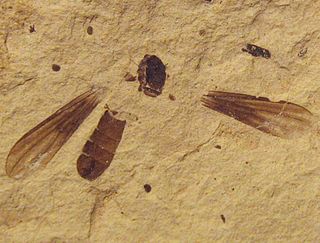Paleontology or palaeontology is the study of prehistoric life forms on Earth through the examination of plant and animal fossils. This includes the study of body fossils, tracks (ichnites), burrows, cast-off parts, fossilised feces (coprolites), palynomorphs and chemical residues. Because humans have encountered fossils for millennia, paleontology has a long history both before and after becoming formalized as a science. This article records significant discoveries and events related to paleontology that occurred or were published in the year 1939.

Metanephrocerus is an extinct genus of big-headed flies in the dipteran subfamily Protonephrocerinae, for which it is one of only two genera. The genus contains four described species, Metanephrocerus belgardeae, M. collini, M. groehni, and M. hoffeinsorum. Metanephrocerus is known from a group of Middle Eocene fossils which were found in Europe and a single early Eocene fossil from North America.
Priabona is an extinct genus of big-headed flies in the dipteran subfamily Nephrocerinae, within which it is one of only two genera. The genus contains a single described species, Priabona florissantius. Priabona is known from a single Late Eocene fossil from western North America.
Pipunculus campestris is a species of fly in the family Pipunculidae. It is found in the Palearctic.

Pipunculinae is a subfamily of big-headed flies.
Dorylomorpha is a genus of flies belonging to the family Pipunculidae.

Nephrocerus is a genus of flies belonging to the family Pipunculidae.
Cephalops is a genus of flies belonging to the family Pipunculidae.
Jassidophaga is a genus of flies belonging to the family Pipunculidae.
Cephalosphaera is a genus of flies belonging to the family Pipunculidae.

Chalarinae is a subfamily of big-headed flies.
Microcephalopsini is a tribe of big-headed flies.
Claraeola is a genus of flies in the family Pipunculidae.

Eudorylini is a tribe of big-headed flies.

Clistoabdominalis is a genus of flies in the family Pipunculidae.

Eudorylas is a genus of flies in the family Pipunculidae.
Pipunculus hertzogi is a species of fly in the family Pipunculidae.
Pipunculus lenis is a species of fly in the Genus, Pipunculus in the family Pipunculidae.
Pipunculus violovitshi is a species of fly in the family Pipunculidae.









